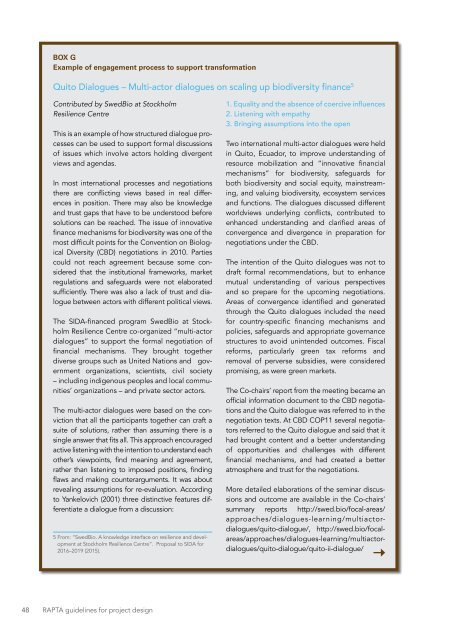DESIGNING PROJECTS IN A RAPIDLY CHANGING WORLD
srun3013fp1
srun3013fp1
You also want an ePaper? Increase the reach of your titles
YUMPU automatically turns print PDFs into web optimized ePapers that Google loves.
BOX G<br />
Example of engagement process to support transformation<br />
Quito Dialogues – Multi-actor dialogues on scaling up biodiversity finance 5<br />
Contributed by SwedBio at Stockholm<br />
Resilience Centre<br />
This is an example of how structured dialogue processes<br />
can be used to support formal discussions<br />
of issues which involve actors holding divergent<br />
views and agendas.<br />
In most international processes and negotiations<br />
there are conflicting views based in real differences<br />
in position. There may also be knowledge<br />
and trust gaps that have to be understood before<br />
solutions can be reached. The issue of innovative<br />
finance mechanisms for biodiversity was one of the<br />
most difficult points for the Convention on Biological<br />
Diversity (CBD) negotiations in 2010. Parties<br />
could not reach agreement because some considered<br />
that the institutional frameworks, market<br />
regulations and safeguards were not elaborated<br />
sufficiently. There was also a lack of trust and dialogue<br />
between actors with different political views.<br />
The SIDA-financed program SwedBio at Stockholm<br />
Resilience Centre co-organized “multi-actor<br />
dialogues” to support the formal negotiation of<br />
financial mechanisms. They brought together<br />
diverse groups such as United Nations and government<br />
organizations, scientists, civil society<br />
– including indigenous peoples and local communities’<br />
organizations – and private sector actors.<br />
The multi-actor dialogues were based on the conviction<br />
that all the participants together can craft a<br />
suite of solutions, rather than assuming there is a<br />
single answer that fits all. This approach encouraged<br />
active listening with the intention to understand each<br />
other’s viewpoints, find meaning and agreement,<br />
rather than listening to imposed positions, finding<br />
flaws and making counterarguments. It was about<br />
revealing assumptions for re-evaluation. According<br />
to Yankelovich (2001) three distinctive features differentiate<br />
a dialogue from a discussion:<br />
5 From: “SwedBio. A knowledge interface on resilience and development<br />
at Stockholm Resilience Centre”. Proposal to SIDA for<br />
2016–2019 (2015).<br />
1. Equality and the absence of coercive influences<br />
2. Listening with empathy<br />
3. Bringing assumptions into the open<br />
Two international multi-actor dialogues were held<br />
in Quito, Ecuador, to improve understanding of<br />
resource mobilization and “innovative financial<br />
mechanisms” for biodiversity, safeguards for<br />
both biodiversity and social equity, mainstreaming,<br />
and valuing biodiversity, ecosystem services<br />
and functions. The dialogues discussed different<br />
worldviews underlying conflicts, contributed to<br />
enhanced understanding and clarified areas of<br />
convergence and divergence in preparation for<br />
negotiations under the CBD.<br />
The intention of the Quito dialogues was not to<br />
draft formal recommendations, but to enhance<br />
mutual understanding of various perspectives<br />
and so prepare for the upcoming negotiations.<br />
Areas of convergence identified and generated<br />
through the Quito dialogues included the need<br />
for country-specific financing mechanisms and<br />
policies, safeguards and appropriate governance<br />
structures to avoid unintended outcomes. Fiscal<br />
reforms, particularly green tax reforms and<br />
removal of perverse subsidies, were considered<br />
promising, as were green markets.<br />
The Co-chairs’ report from the meeting became an<br />
official information document to the CBD negotiations<br />
and the Quito dialogue was referred to in the<br />
negotiation texts. At CBD COP11 several negotiators<br />
referred to the Quito dialogue and said that it<br />
had brought content and a better understanding<br />
of opportunities and challenges with different<br />
financial mechanisms, and had created a better<br />
atmosphere and trust for the negotiations.<br />
More detailed elaborations of the seminar discussions<br />
and outcome are available in the Co-chairs’<br />
summary reports http://swed.bio/focal-areas/<br />
approaches/dialogues-learning/multiactordialogues/quito-dialogue/,<br />
http://swed.bio/focalareas/approaches/dialogues-learning/multiactordialogues/quito-dialogue/quito-ii-dialogue/<br />
48 RAPTA guidelines for project design


